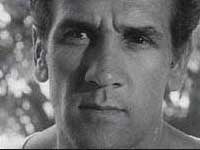
Charles Perkins at the time of the
Freedom Rides |
 |
 |
Freedom Rides
By Kezia Dawkins
The Freedom Ride set off on the night of the 12 February 1965.
Its aim was to campaign, in the country towns of New South
Wales, against racial discrimination that was rife in these
insular communities.
In 1965 Aboriginal people were not citizens. They were
dispossessed from the land, which they lived on before
colonisation. They were forced to all live together on small
pockets of land on the edge of towns. These places were called
reserves and missions. The living conditions of these places
were atrocious. There was sub-standard housing, with people
living in shanties. There was no plumbing, no electricity and no
amenities. Things were hard for Aboriginals on these reserves,
and even harder in the towns. In town there was unbearable
racism. Aboriginals did not have access to amenities, such as
cafes, cinemas, theatres, hotels and swimming pools; things
taken for granted today. Not only that, but there was a lot of
verbal, and sometimes physical, abuse, just because they were
Aboriginal.
In the 1960’s, through television and the press, Australia was
also becoming aware of what was happening in Southern States of
America with the civil rights movement. In Canberra on May 1964,
2000 university students protested in front of the US consulate
supporting the Civil Rights Bill which was before Congress.
Within all this social awareness and revolution came Charles
Perkins. Charles had enrolled at Sydney University in 1963, and
along with Gary Williams, made up the first Aboriginal students
to attend Sydney University. Charles had travelled abroad to
play soccer, and in doing so had been exposed to different
societal behaviour. He believed that his people deserved more,
and that racial discrimination was holding them back. Thus
Charles decided to confront white Australians about their
treatment of Aboriginal people.
To do this he decided to duplicate the US Freedom rides, get a
bus and travel rural NSW to protest against the segregation that
was prevalent. 29 other students set off with Charles on the
night of the 12 February.
The first two towns they went to were Wellington and
Gulargumbone. Here they conducted surveys with Indigenous and
non-Indigenous people to find out about the living conditions
and their points of view. This reaffirmed what they thought the
situation was - extremely bad. Though, because of the deficiency
of contact and support from the Indigenous community, they did
not protest in these towns, instead moving onto the next ones.
On the 15 February the students pulled up in Walgett. They had
decided that to confront the racism they would picket the
Walgett RSL. The RSL was symbolic. It was in the memory of the
past wars, and the ANZAC, that Australia found the deepest sense
of ‘mateship’ and nationhood. It was high in the Australian
culture and psyche. Unfortunately this comradeship did not
extend to Aboriginal ex-servicemen. They were only allowed to
use the RSL facilities on ANZAC day, if at all.
The Walgett RSL protest went extremely well. A cadet reporter
for the Herald was in Walgett at the time and took some photos
of the protest; finally they had the media coverage that gave
them the greater audience the students were hoping for. That
night the students were asked to leave the church hall that they
were spending the night in. The bus left Walgett in the middle
of the night, but as they were leaving the town a grazier’s son
rammed the bus off the road. Luckily no one was injured, and
coincidently there was a journalist on board, making the
incident headlines in the Sydney Morning Herald.
Onto Moree for the Freedom Riders, where they were met by more
members of the press. In Moree they decided to address the
segregation of the local swimming pool. The protester had a
three point plan here, firstly to protest out the front of the
council chambers, then to take Aboriginal children to the pool
and lastly to hold a public meeting in the evening. It was a
great success with the students feeling that they had
desegregated the public pool.
By this stage the Freedom Ride had national and international
press coverage. The bus stopped along the east coast at Lismore,
Bowraville and Kempsey before returning home to Sydney.
With their return there was greater awareness of Indigenous
issues rurally. They had successfully stirred up debate on the
state of Aboriginal affairs around Australia. With the press
coverage they had obtained, came pressure from outside and
within Australia for reform. This debate was maintained up the
1967 Referendum. The Freedom Rides have also been credited with
helping end the ‘White Australia’ policy.
|